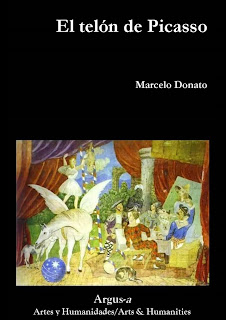Esta obra relata la historia de una pieza de escenografía, el telón de boca que Picasso diseñó para el ballet Parade en 1917.
 El relato comienza en París antes de la primera guerra mundial. Mientras las danzas de Mata Hari deslumbran a los franceses, Jean Cocteau le propone a Sergue Diaghilev el espectáculo Parade para sus Ballets Rusos. Cocteau convoca a Eric Satie para crear la música y a Pablo Picasso para la escenografía y el vestuario. La coreografía lleva la firma de Léonide Massine. El ballet se estrena en París en 1917, con la primera guerra mundial ya iniciada. Fue un gran fracaso, pero marca un punto de inflexión en la historia de la danza. Picasso pinta un telón de boca (que se ve solamente antes de comenzar el espectáculo) de 17 por 10 metros que pasa a la historia. También crea vestuarios cubistas para los bailarines.
El relato comienza en París antes de la primera guerra mundial. Mientras las danzas de Mata Hari deslumbran a los franceses, Jean Cocteau le propone a Sergue Diaghilev el espectáculo Parade para sus Ballets Rusos. Cocteau convoca a Eric Satie para crear la música y a Pablo Picasso para la escenografía y el vestuario. La coreografía lleva la firma de Léonide Massine. El ballet se estrena en París en 1917, con la primera guerra mundial ya iniciada. Fue un gran fracaso, pero marca un punto de inflexión en la historia de la danza. Picasso pinta un telón de boca (que se ve solamente antes de comenzar el espectáculo) de 17 por 10 metros que pasa a la historia. También crea vestuarios cubistas para los bailarines.
El telón viaja a Buenos Aires en 1939 junto a varias obras de arte francesas para ser presentados en una exposición en el Museo Nacional de Bellas Artes antes de la Segunda Guerra Mundial. Arturo Jacinto Álvarez, un excéntrico coleccionista y escritor, fundador de la Editorial La Perdiz, se enamora del telón, lo compra y lo transporta a su propiedad en la Provincia de Buenos Aires. El texto, que inicia con fuentes muy precisas, se transforma en esta segunda parte en una especulación, un intento de reconstruir la figura de Arturo Jacinto Álvarez basado en su obra literaria, informaciones recogidas en medios periodísticos y entrevistas a gente que lo conoció.
Quince años después el telón vuelve a Europa para una exposición y los expertos de arte se movilizan para recuperar la preciada pieza que hoy forma parte de la Colección del Museo de Arte Moderno de París (Centre Pompidou). En la ficha del telón, adquirido en 1955, hay un espacio vacío de toda información, correspondiente a los 15 años que el telón estuvo en Argentina.
La parte final del libro ofrece informaciones encontradas posteriormente en otras fuentes que presentan diferentes hipótesis que no han sido comprobadas y abren nuevos interrogantes, junto a una lúdica historia contada por el telón
Picasso's front curtain
This work tells the story of a set design piece, the curtain that Picasso created for the ballet Parade in 1917. The story begins in Paris before the First World War. While the dances of Mata Hari dazzle the French, Jean Cocteau proposes Sergue Diaghilev Parade, a ballet for his Russian Ballets. Cocteau summons Eric Satie to create the music and Pablo Picasso for the scenography and costumes. The choreography is signed by Léonide Massine. The ballet opens in Paris in 1917, with the First World War already started. It was a great failure but it marks a turning point in the history of dance. Picasso paints a 17 by 10 meter curtain (to be seen only before the show begins) that goes down in history. He also creates cubist costumes for dancers.
The curtain traveled to Buenos Aires in 1939 along with several French works of art to be presented in an exhibition at the National Museum of Fine Arts. Arturo Jacinto Álvarez, an eccentric collector and writer, founder of Editorial La Perdiz, falls in love with the curtain, buys it and transports it to his rural property in the Province of Buenos Aires. This second part is an attempt to reconstruct the figure of Arturo Jacinto Álvarez based on his literary work, information collected in the journalistic media and interviews with people who knew him.
Fifteen years later the curtain returns to Europe for an exhibition and art experts mobilize to recover the precious piece that is now part of the Collection of the Museum of Modern Art in Paris (Center Pompidou). In the file on the curtain, acquired in 1955, there is a empty space corresponding to the 14 years that the curtain was in Argentina.
The final part of the book offers information subsequently founded in other sources that presents different hypotheses that have not been verified and opens new questions, along with a playful story told by the curtain itself.


